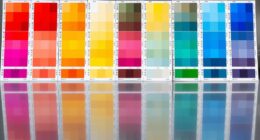Rayleigh scattering causes the sky’s blue color because Earth’s atmosphere scatters shorter wavelengths like blue more efficiently than violet. Your eyes are more sensitive to blue light, making it appear more vivid, while violet is often absorbed by the upper atmosphere. This combination results in a blue sky rather than violet. If you want to understand why this happens in more detail, there’s a lot more to explore about how atmospheric physics shapes what you see every day.
Key Takeaways
- Human eyes are less sensitive to violet light, making blue appear more prominent in the sky.
- Violet light is scattered more strongly than blue but is absorbed by the upper atmosphere.
- The Earth’s atmosphere contains nitrogen and oxygen molecules that preferentially scatter blue light.
- The sky appears blue because our visual system is more responsive to blue wavelengths.
- The combination of scattering efficiency and human vision explains why the sky isn’t perceived as violet.

Have you ever wondered why the sky appears blue during the day? It’s a fascinating result of a process called Rayleigh scattering, which involves how sunlight interacts with the Earth’s atmosphere. When sunlight reaches the atmosphere, it’s made up of various colors, each with different wavelengths. The shorter wavelengths—blue and violet—are scattered more efficiently than the longer wavelengths like red and orange. This scattering causes the sky to glow with a blue hue, but interestingly, the sky isn’t violet, even though violet light is scattered even more strongly. The key to understanding this lies in polarization effects and the composition of the atmosphere itself.
Rayleigh scattering occurs because molecules and tiny particles in the atmosphere are much smaller than the wavelength of visible light. When sunlight hits these particles, it’s scattered in different directions, with blue light being scattered about 16 times more than red. This selective scattering explains why the sky appears mainly blue to us during the day. The polarization effects also play a role here—scattered light becomes partially polarized, which means the light waves vibrate in specific directions. When you look at the sky through polarized sunglasses, you notice this effect more clearly, as it reduces glare and enhances the blue shades. These polarization effects are a direct consequence of how sunlight interacts with atmospheric molecules, which are primarily nitrogen and oxygen.
Additionally, the atmospheric composition influences the scattering process, affecting how vivid the sky appears in different conditions. The atmospheric composition is essential because it determines how much of each wavelength gets scattered. Since nitrogen and oxygen molecules are the main components, they influence which colors dominate the sky. These molecules efficiently scatter the shorter wavelengths but are less effective with longer wavelengths, like red and orange. Because the violet end of the spectrum is scattered even more, why don’t we see a violet sky? It’s partly because our eyes are less sensitive to violet light, and partly because some of that violet is absorbed by the upper atmosphere. Additionally, the human eye perceives blue more vividly, especially under the conditions set by Rayleigh scattering.
Frequently Asked Questions
How Does Rayleigh Scattering Affect the Color of Sunsets?
When you observe sunsets, scattering mechanisms involving atmospheric particles cause the sky to display warm hues. As the sun dips, its light travels through more atmosphere, scattering shorter blue and violet wavelengths out of your line of sight. This allows longer wavelengths like red and orange to dominate, creating the stunning colors you see. The scattering mechanisms selectively filter the light, giving sunsets their characteristic fiery appearance.
Why Is the Sky More Blue During the Day Than at Dawn or Dusk?
During the day, you notice the sky is more blue because of sky brightness caused by atmospheric density. When the sun is high, its light passes through less atmosphere, scattering more blue light toward you. At dawn or dusk, the light travels through a thicker atmosphere, scattering away most blue and allowing reds and oranges to dominate. This change makes the sky appear less blue and more colorful during those times.
Does Rayleigh Scattering Influence the Appearance of Distant Mountains?
You might think Rayleigh scattering affects distant mountains’ appearance, but it mainly influences the sky’s color, not mountain visibility. When atmospheric clarity is high, distant mountains appear sharper and more vivid. If the air is hazy or polluted, scattering causes a duller view. While Rayleigh scattering affects the sky, it’s atmospheric clarity that truly determines how clearly you see distant mountains, making them appear more or less vibrant and detailed.
How Does Atmospheric Pollution Impact Rayleigh Scattering and Sky Color?
You might notice that pollution effects change the sky’s color by adding atmospheric particles. These particles scatter sunlight differently than clean air, often causing the sky to look duller or more gray. When pollution increases, smaller particles may enhance Rayleigh scattering, but larger pollutants tend to cause Mie scattering, which makes the sky appear hazier and less vibrant. So, pollution impacts how we perceive sky color daily.
Can Rayleigh Scattering Explain the Color of Other Planets’ Skies?
You might find it fascinating that scattering mechanisms like Rayleigh scattering can explain the colors of other planets’ skies. In planetary atmospheres, different gases and particles influence light, creating unique hues. For example, Mars’ reddish sky results from dust particles, while Venus’ thick clouds produce a yellowish tint. These colors depend on atmospheric composition and the scattering processes, showing that Rayleigh scattering isn’t limited to Earth but plays a role in shaping planetary skies across the universe.
Conclusion
So, next time you look up and marvel at the sky’s blue hue, remember how it’s a happy coincidence—our eyes are more tuned to see blue than violet, and the atmosphere scatters blue light more effectively. It’s like nature’s little secret, turning what could be a violet wonder into a familiar, calming blue. Sometimes, it’s the quirks of physics and biology working together that paint the sky we love to gaze at every day.









